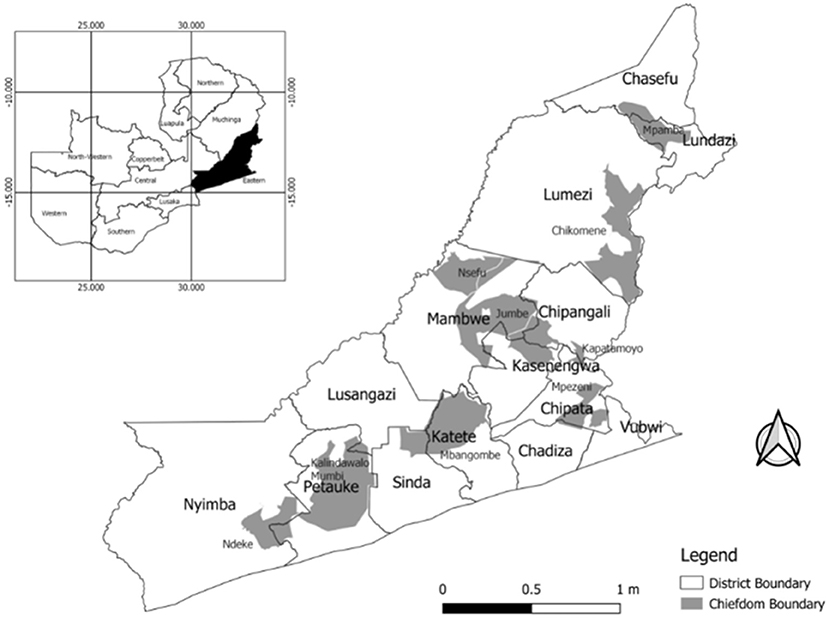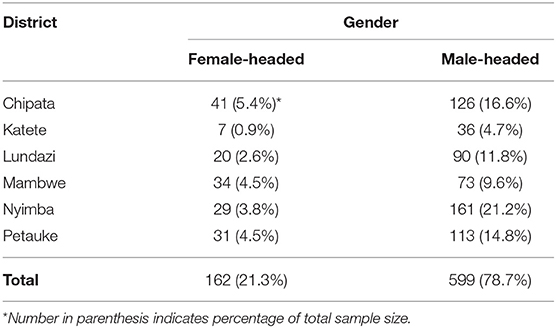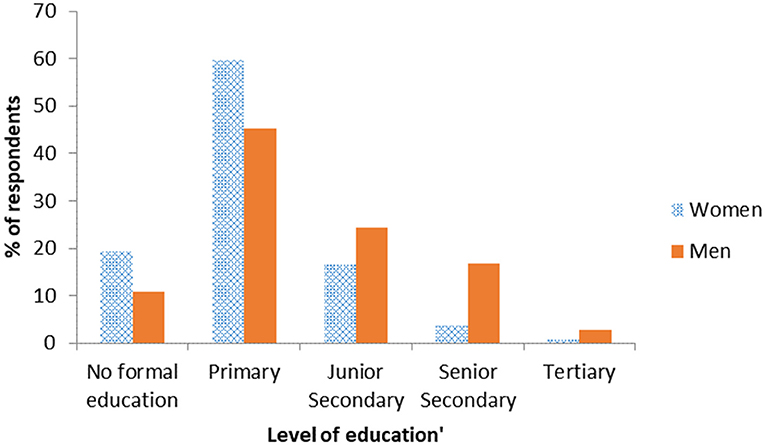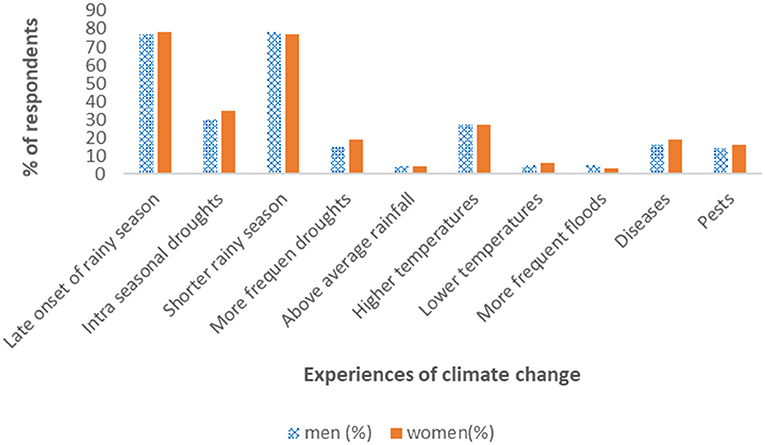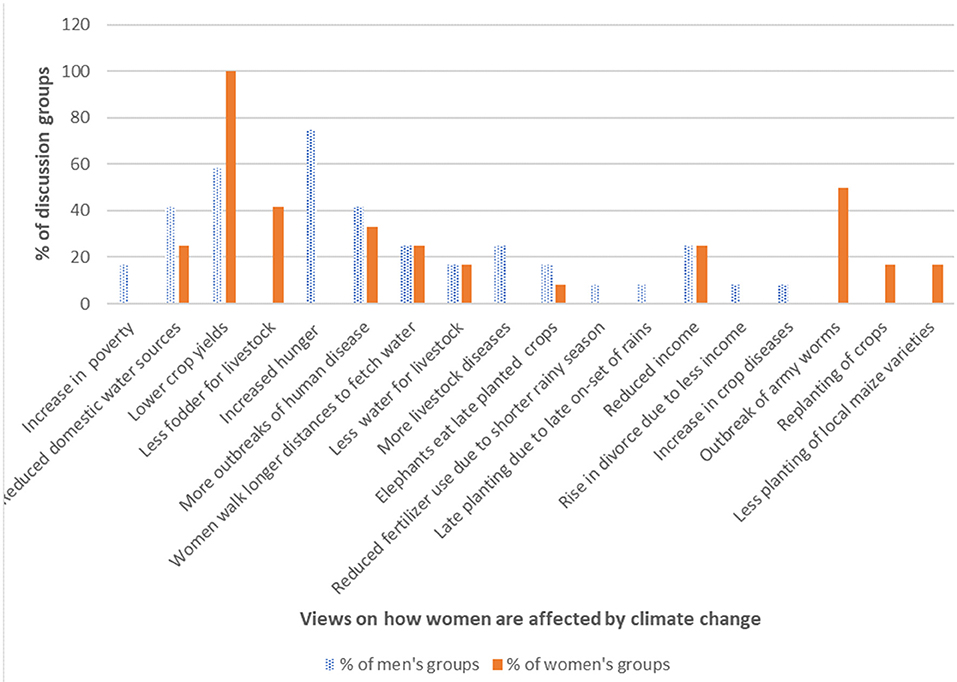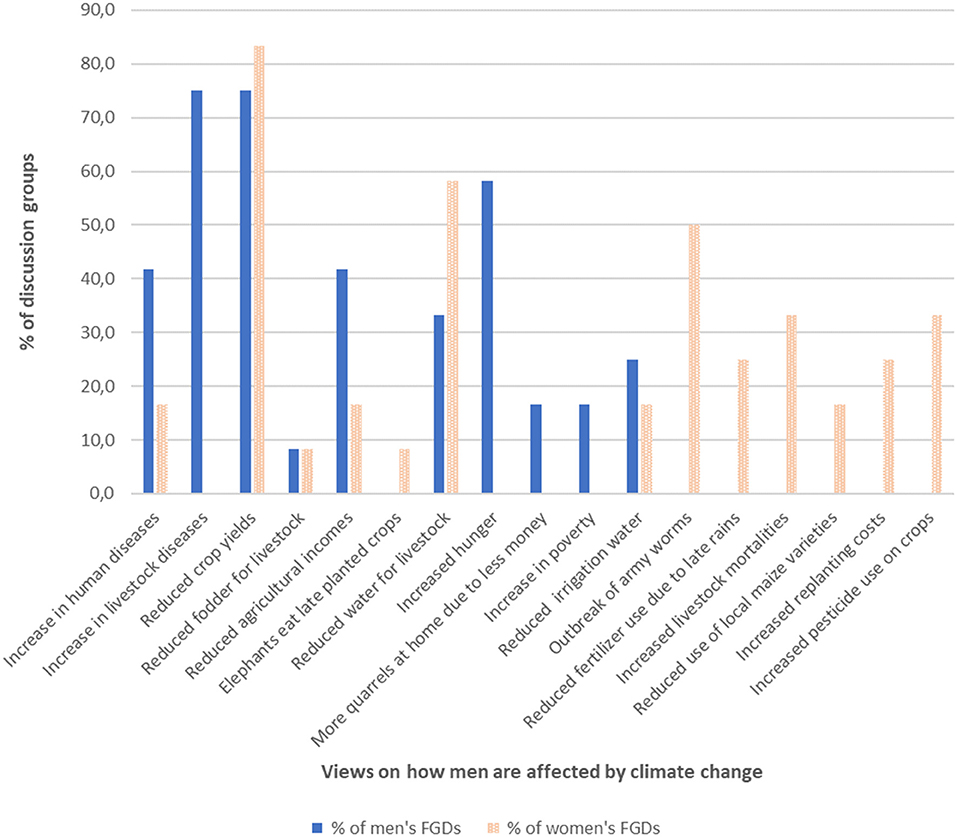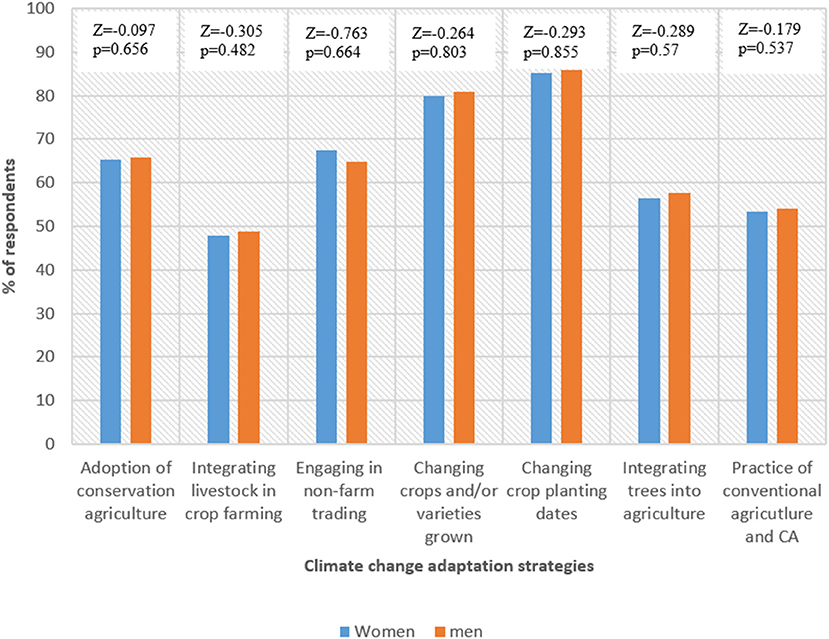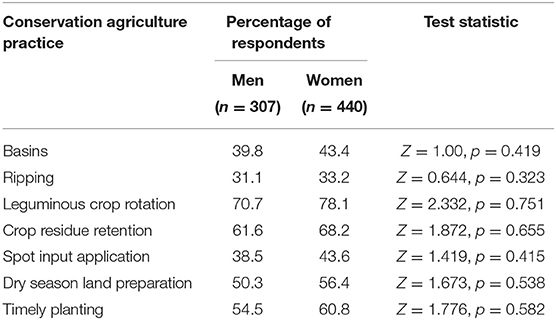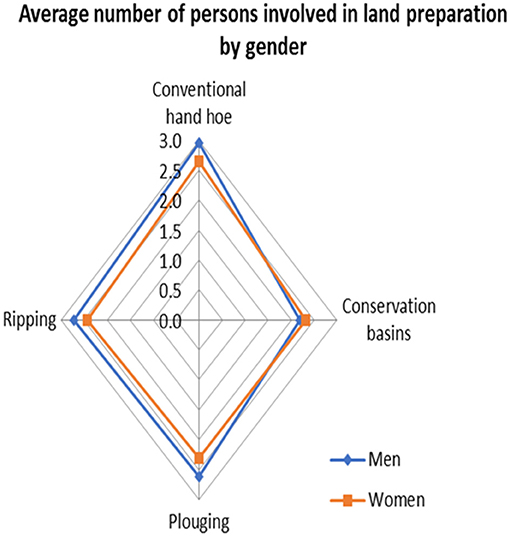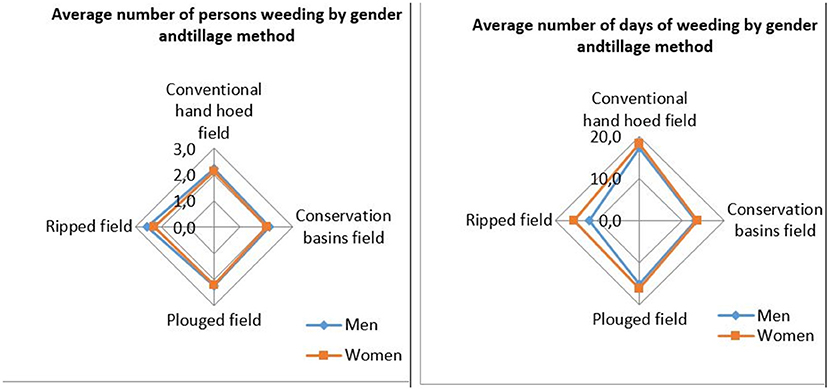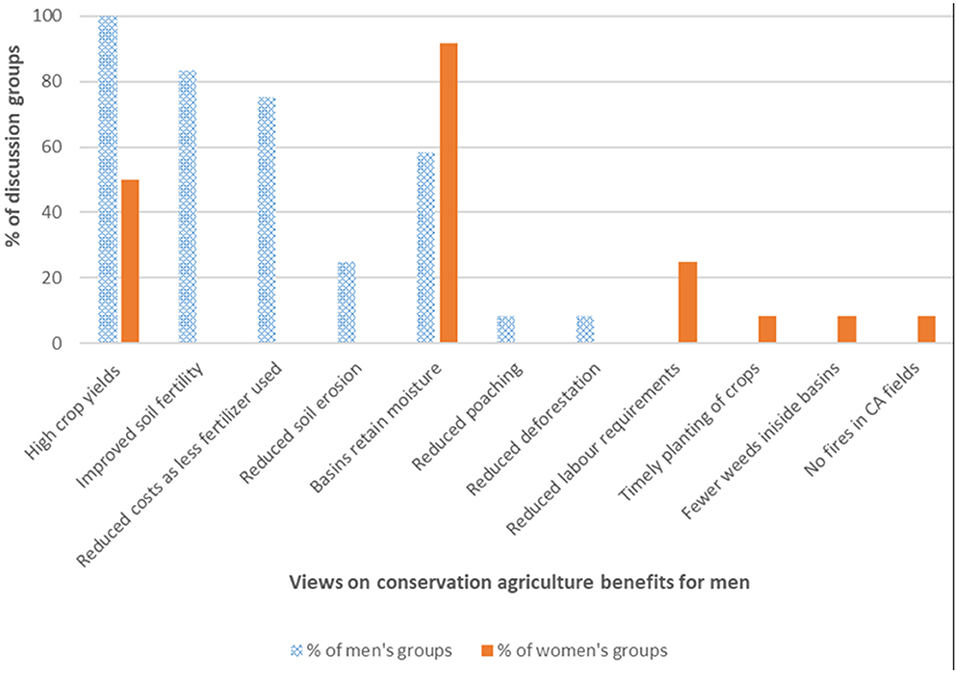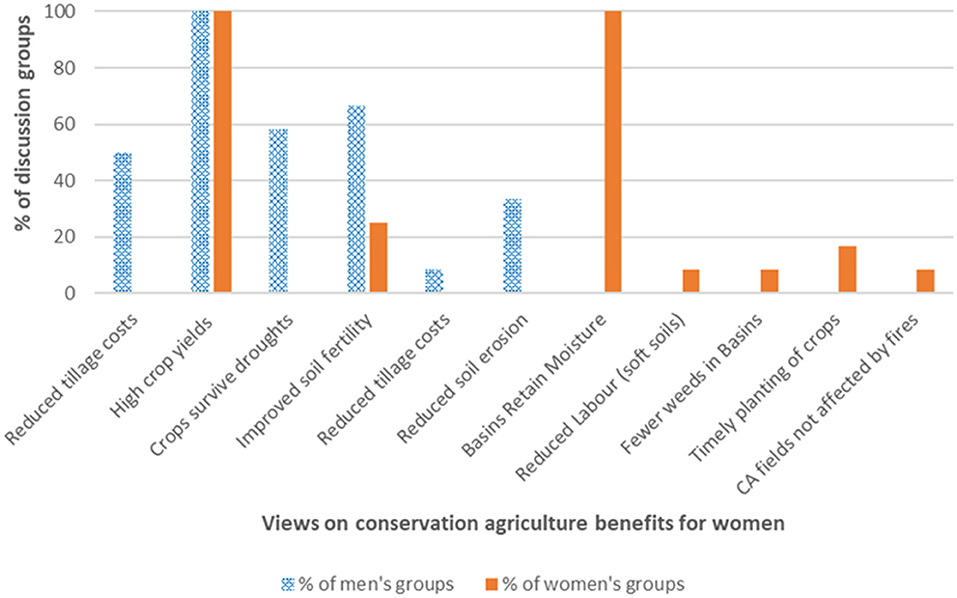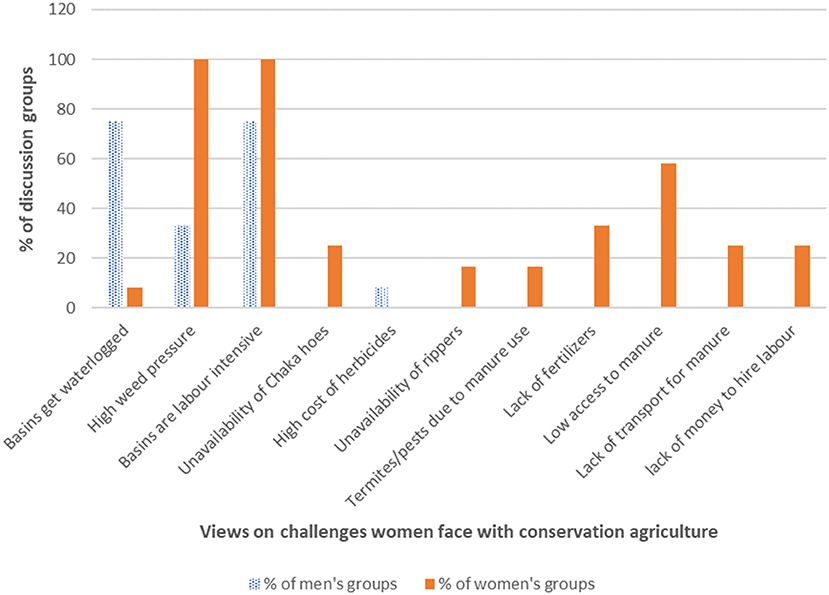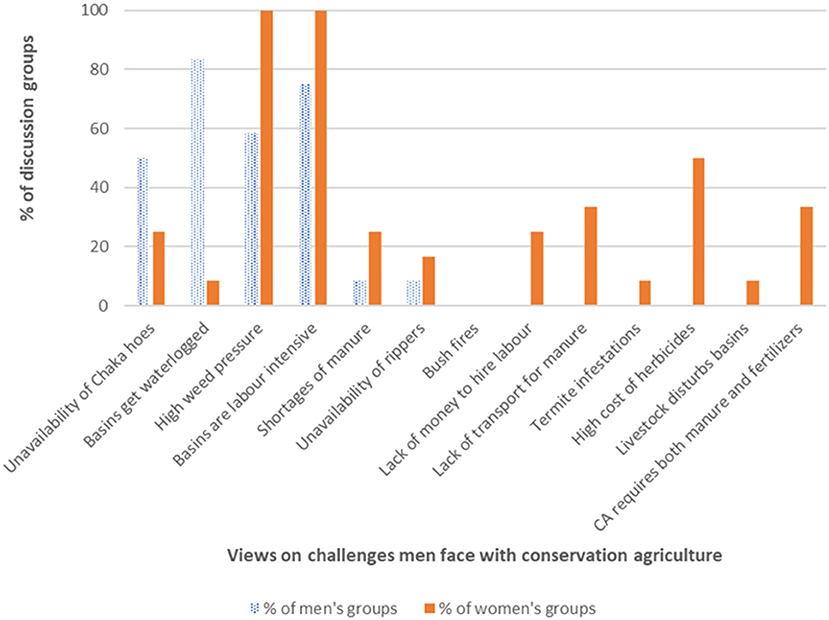- 1Nordic Africa Institute, Uppsala, Sweden
- 2Department of Geography and Environmental Studies, University of Zambia, Lusaka, Zambia
This study explored the use of conservation agriculture (CA) as a climate adaptation strategy among smallholder farmers in Eastern Zambia. Using 761 household interviews and 33 focus group discussions (FGDs) with smallholder farmers from six districts, data was collected on how smallholder farmers in the region experience climate change, what CA practices they had adopted, and benefits and challenges associated with CA practice. Results show that men and women farmers had similar experiences of climate change, namely late onset of a shortened rainy season, intra-seasonal drought and higher temperatures. Farmers' perceptions of gender-mediated effects of climate change had important nuances. The three most cited effects of climate change on women mentioned by women were lower crop yields, outbreaks of armyworms and reduced livestock fodder. The men thought women were most affected by increased hunger, lower crop yields and reduced domestic water sources. According to the women FGDs, men were most affected through reduced crop yields, increases in livestock diseases and increased hunger. The men self-reported reduced crop yields, reduced water for livestock and outbreaks of armyworms. Both men and women saw CA as having climate change adaptation benefits. For the women, men most benefitted from CA through the high moisture holding capacity of basins, higher crop yields and reduced labor requirements through use of oxen ripping. The men most appreciated the high crop yields, improved soil fertility and reduced costs as less fertilizer is used. The women cited the high moisture holding capacity of basins, high crop yields and improved soil fertility as benefits they most commonly derived from CA, while the men thought the women most benefitted from CA through the higher crop yields, improved soil fertility and crop tolerance to droughts. The study concludes that there is room for CA to serve as a climate smart agricultural system for both men and women smallholder farmers in Eastern Zambia. However, this will require addressing important challenges of high weed pressure, high labor demands, and low access to manure, and CA farming implements. The CA package for Zambia should include access to timely climate information and climate informed crop choices.
Introduction
The Inter-Governmental Panel on Climate Change (IPCC)'s Fourth Assessment Report recognized that gender roles and relations shape vulnerability and people's capacity to adapt to climate change (IPCC, 2007). The report noted that rural women in developing countries were one of the most vulnerable groups. Extensive empirical literature has shown that female-headed farming households in Sub-Saharan Africa produce up to 40% less than male-headed households (Udry et al., 1995; Goldstein and Udry, 2008; Doss et al., 2011; FAO, 2011; Kilic et al., 2015; Slavchevska, 2015; Gebre et al., 2021) and earn less income (Zulu-Mbata and Chapoto, 2016; Teklewold et al., 2019). This is attributed to systematic and persistent differentials in access to and use of agricultural inputs; tenure security and related investments in land; market and credit access; and informal institutional constraints (Doss and Morris, 2000; Alene et al., 2008; Johnson et al., 2015; Kilic et al., 2015). Women's less access to productive agricultural resources makes them more vulnerable to climate change/variability effects. Women are likely to be more negatively affected by climate change than men are because they have fewer resources with which to adapt to it (Thomas et al., 2007; Goh, 2012; Antwi-Agyei et al., 2013). Women's greater vulnerability compared with men also arises from social and cultural norms (Terry, 2009; Codjoe et al., 2012; Goh, 2012). For instance, gendered divisions of labor, physical mobility, and participation in decision making at household and community levels are socio-cultural norms that mediate women's vulnerability to climate change effects.
Women's roles entail that their perceptions of climate risk may be different from those of the men in important ways (Lambrou and Nelson, 2010). Men and women have different social positions and obligations, which means they have different opportunities to incorporate climate change adaptation strategies into their lives (Seasoned Development Solutions, 2021). Parks et al. (2015) found that men and women had different access to assets, gender roles, and soil perceptions that could have implications for whether farmers adopt conservation agriculture in the Philippines. In their study in Andhra Pradesh, India, Lambrou and Nelson (2010) found that men were significantly more likely than women to report there was less fodder and that boreholes and ponds had dried up while women were significantly more likely than men to report that health was affected.
In targeting smallholder-based agricultural growth, national development plans across sub-Saharan Africa have emphasized the reduction of gender differences in agricultural productivity (Kilic et al., 2015; Johnson et al., 2018; AU/NEPAD, 2019). With the reported increased frequency and intensity of extreme climatic change events in sub Saharan Africa (Thierfelder and Wall, 2010; Asafu-Adjaye, 2014; Stevens and Madani, 2016; Government of the Republic of Zambia, 2017; Zougmoré et al., 2018), most agricultural interventionists have endeavored to promote adaptation to and mitigation of climate change effects by including climate resilient agricultural technologies to their development packages (Government of the Republic of Zambia, 2016; AU/NEPAD, 2019; Michler et al., 2019; Teklewold et al., 2019; Diko et al., 2021). This has resulted in the promotion of climate smart agriculture among smallholder farming communities in several countries across the region (Andrieu et al., 2017; Zougmoré et al., 2018). The Food and Agricultural Organization (FAO) conceptualizes climate-smart agriculture as an approach that helps to guide actions needed to transform and re-orient agricultural systems to effectively support development and ensure food security in a changing climate (FAO, 2013). FAO elaborates that climate-smart agriculture aims to tackle three main objectives: (i) sustainably increasing agricultural productivity and incomes; (ii) adapting and building resilience to climate change; and (iii) reducing and/or removing greenhouse gas emissions, where possible.
In Zambia, attempts to transform and re-orient conventional agricultural systems to ensure food security amidst a changing climate have been made through the promotion of conservation agriculture (Haggblade and Tembo, 2003; Nyanga, 2012). Conservation Agriculture (CA) is any agricultural system based on three main principles: minimal soil disturbance, permanent soil cover and crop rotations. The principles are lauded to be universally applicable in all agricultural landscapes and cropping systems and adaptable to local conditions and needs (FAO, 2016). Common CA practices promoted in Zambia are dry-season preparation of a precise grid of basins using hand hoes; dry-season ripping using oxen or tractor; retention of crop residues within field; spot application of inputs such as seeds, fertilizers, lime and manure; and crop rotations that include annual legumes (Umar et al., 2011).
CA is hypothesized to mitigate climate change (Hobbs and Govaerts, 2010; Farnworth et al., 2016; Gonzalez-Sanchez et al., 2018; O'Dell et al., 2020). It is reportedly effective in mitigating the negative impacts of deviations in rainfall (Thierfelder and Wall, 2010; Umar and Nyanga, 2011; Michler et al., 2019). Using nationally representative data, Zulu-Mbata and Chapoto (2016) found that male headed households tended to practice ripping (animal draft powered and mechanized tillage) more than female headed households, while females in female headed households tended to practice crop rotation more than farmers in other household dynamics.
Integrating CA practices inevitably affects on-farm gender relations, notably resource allocation as well as having an impact upon the ability of women and men to realize their gender interests (Farnworth et al., 2016). Empirical studies have shown that shifting of labor from tasks performed by men to those performed mainly by women when CA is adopted lead to increases in women's labor burdens (Baudron et al., 2009; Giller et al., 2009; Nyanga et al., 2012). Although some CA proponents present basins as being apt for women farmers, the technology was not tailor made for women. Its use by men and women farmers results in differentiated outcomes. Women found the Chaka hoe-designed for use in making basins-to be very heavy to use and manual weeding of basis laborious (Andersson et al., 2011; Rusinamhodzi, 2015). Generally, agricultural technology adoption outcomes depend on local context (socio-cultural, policy, and biophysical environment). As noted by Gebre et al. (2019) agricultural technology adoption in relation to gender is context-specific and common conclusions are challenging to reach. In promoting CA as a “one size fits all” technology package without much attention for existing farming practices and the suitability of the promoted technologies within the socio-economic context in which they are to be adopted (Baudron et al., 2012), CA protagonists risk low adoption levels and sub-optimal outcomes. CA interventions in Southern Africa have resulted in low adoption (Brown et al., 2017; Bouwman et al., 2021), disadoption of CA post project (Arslan et al., 2014; Chinseu et al., 2019; Habanyati et al., 2020) and conflicts between some CA and conventional agriculture practices (Giller et al., 2009; Thierfelder et al., 2012; Valbuena et al., 2012). Thus, micro and meso level studies are important to inform planned agricultural interventions (see Sumner et al., 2017 for the importance of understanding gendered practices and perspectives in CA technology promotions). After a systematic review of sustainable intensification, Himmelstein et al. (2016) advised that methodologies must depend upon adaptations of several development techniques for different types of communities. For this reason, the World Bank, in conjunction with TerrAfrica commissioned a study to build evidence on gender concerns in the context of projects and programmes focused on sustainable land management and climate change in Eastern Zambia. Previous interventions and studies in the region focused on the promotion of agricultural technologies without due consideration to the central role of gender roles and gender relations in mediating outcomes among the smallholder farming communities. This study aims to narrow this knowledge gap and contribute to theory on gender responsive analysis of conservation agriculture and sustainable land management. It provides a methodological roadmap for development interventionists by highlighting the importance of socio-cultural and biophysical context in the outcomes of agricultural development projects.
Eastern Zambia was purposively selected because of its rich history with sustainable land management interventions by an array of development actors. Agricultural development interventions have been focused on the region because it is an agricultural region with untapped potential. Eastern province had 349,980 agricultural households during the 2017/2018 agricultural season. Of these, 77.7% were male headed while 22.3% were female headed. Almost all the households (97.7 and 97.2% for male and female-headed households respectively) produced crops. Livestock was raised by 77.9 and 64.7% of the male headed and female-headed households respectively (Ministry of Livestock and Fisheries, 2019). About 5% of farming households had fully adopted CA while 7% were partial adopters in 2014 (Zulu-Mbata and Chapoto, 2016). In its Seven National Development Plan (2017 to 2021), the Government of the Republic of Zambia committed to ensure equitable distribution of national resources between women and men, girls and boys for meaningful impact in the medium and long-term on poverty reduction among women and girls.
This sub component of the study aimed to examine the practice and benefits of CA in Eastern province through a gender lens. It was guided by four research questions; (i) to what extent do experiences of climate change differ between men and women smallholder farmers in the Eastern province? (ii) how do men and women smallholder farmers practice CA in Eastern Province (iii) what benefits do men and women smallholder farmers derive from CA, and (iv) What challenges do men and women smallholder farmers face in the of practice of CA. These research questions were based on the premise that there are important differences in gender roles which mediate how men and women smallholder farmers practice and the conditions under which they practice CA in Eastern province. Local gender norms and practices mediate the benefits women and men accrue from CA. This study contributes to understanding how men and women farmers in Eastern province have benefited from CA as a climate smart agricultural system; and the challenges they have faced in their practice of CA. This information is useful to interventionists with agricultural development programmes in the region. The study also contributes to scholarship on CSA in Sub Saharan Africa. The rest of the article is organized as follows; the next section details the research methodology and explains how the primary data for the study was collected from a range of sources. This is followed by a combined results and discussion section, after which the study is concluded.
Methodology
Study Area and Context
The study was conducted in the rural parts of six out of 11 districts of the Eastern Province in Zambia (Figure 1). The Eastern Province experiences seasonal rainfall of between 800 and 1000 mm and a crop-growing period of 100–140 days. This is suitable for production of a range of annual crops and raising of livestock. Like other regions of Zambia, the Eastern Province is characterized by three seasons, warm and wet (from November to May), cold and dry (June to august) and hot and dry (September to November). Zambia has a uni-modal rainy season, around which smallholder agricultural activities are organized. Pre-tillage land preparation activities usually begin in October. After the first rains and a softening of the soils, tillage begins in late October/early November. Planting begins as soon as the first effective rains are recorded, from around mid-November and goes on until December. Each field is weeded between 1 and 3 times, depending on the crop planted and the availability of labor. Harvesting of fresh maize starts as early as March while the main harvest period is only after the rainy season has ended and the maize crop has dried. Between May and June, all the crops are harvested and readied for the marketing season, which lasts until October when the cycle repeats.
Majority of the rural dwellers in the province are engaged in rain-fed agricultural production while some do irrigated vegetable production during the dry season. The main crops grown are maize (Zea Mays), groundnuts (Arachis hypogaea), cotton (Gossypium hirsutum), tobacco (Nicotiana tabacum), soya beans (Glycine max), sweet potatoes (Ipomoea batatas), cowpeas (Vigna unguiculata), millet (Panicum miliaceum), sorghum (Sorghum bicolor), rice (Oryza sativa), cassava (Manihot esculenta), common beans (Phaseolus vulgaris) and sunflower (Helianthus annuus). Common livestock reared are cattle, goats, and pigs. Almost every household has free-range chickens, and less commonly ducks, guinea fowls, and geese.
Research Strategy and Data Collection Methods
An exploratory sequential mixed method research design was used (Bryman, 2012). An initial phase of qualitative data collection using focus group discussions (FGDs) and unstructured interviews with key informants was followed by a quantitative cross sectional household survey component. The qualitative phase of the study was essential for the researchers to understand the local socio-cultural, political and institutional context. The insights gained from the qualitative part of the study informed the issues to examine during the household survey. The FGDs and key informant interviews further provided insights into structural factors and power relations that were not obvious from the household survey.
Data was collected from 33 focus group discussions and 761 households in 11 chiefdoms namely Chikomeni, Chikube, Jumbe, Kalindawalo, Kapatamoyo, Mban'gombe, Mpamba, Mpezeni, Mumbi, Ndake and Nsefu. Two stage probability sampling was done to select survey respondents. The first stage involved the purposive selection of the districts and chiefdoms to cover different tribes, areas most dependent on agriculture and forest resources for livelihoods and where sustainable land management projects have been implemented. The second stage involved a random selection of proportionate number of households using village registers. The focus group discussants were initially separated into single gender groups, men and women. The initial separation into single gender groups was important to minimize any potential influence of unequal gender relations. The groups were combined in a plenary session and asked to present summaries of their group deliberations. Gender was conceptualized as the socially constructed roles and behaviors that a society typically associates with males and females.
The FGDs were conducted in the local dialects of the province namely Tumbuka, Ngoni, Nsenga, Chewa and Kunda. Members of the research team expertly facilitated the discussion, observed the proceedings and took notes. The facilitators alternated which group shared its results first. Both facilitators and observers paid attention to the verbal and non-verbal reactions of the women to the men's answers, and vice versa. Informed consent was obtained and permission to record the discussions using digital recorders was sought and granted for all the sessions. Respondents for the household survey were selected from gender-disaggregated lists of previous sustainable land management project participants in each Chiefdom. Key informant interviews were conducted with experts from non-governmental organizations and government agencies operating in the agricultural sector in the study sites.
Data Analysis
The recordings of the focus group discussions were transcribed into English. They were then analyzed using thematic analysis method with the aid of the qualitative analysis software QDA Miner 4.0 (Provalis Research, 2011). Four themes were selected based on the research objectives as follows; experiences of climate change, CA practices, benefits of CA, and Challenges of CA. The quantitative data was analyzed using MINITAB 18 (MINITAB, 2017) to test for differences in household sizes and age between male and female-headed households using Two-Independent sample T-Test; to test for differences in household size among the six study districts, livestock and implement ownership using ANOVA; differences in proportions between male and female respondents using two-sample Z-proportions test. All the analyses were conducted at 5% level of significance.
Results and Discussion
Social–Demographic Characteristics of Study Respondents
Of the 761 households interviewed during the survey, about 79% were male-headed with the remaining 21% of the sample representing female-headed households (Table 1).
Overall, a significant proportion of the respondents had attained primary level of education (Figure 2). The results show that men were generally more educated than women were.
Household size was used as a crude proxy variable for labor availability. On average, each household had a total of 6 members. In addition, there were ~3 males and 3 females in each household. However, there was a statistically significant difference in the household size between female-headed households with an average of 5 individuals and male-headed households with an average of 6 (T = −4.52; p = 0.001). The average household size also differed statistically among districts particularly Lundazi differed from Petauke, and Nyimba (F = 2.917; p = 0.013). Petauke district had 7 members on average while Nyimba had 6 members and Lundazi district had 5 members. Most of the respondents were married (77.5%). The average age of men were significantly higher (44.9) than that of women (40.8), (T = 5.36; p = 0.001). More results on social economic characteristics are presented as supplementary material (Supplementary Table 1). Married households, synonymous with large families and associated labor availability are more likely to adopt new practices, especially those that are more time consuming e.g., basins under CA (FAO and UNDP, 2020). Smaller household sizes for female-headed households meant lower access to labor, compared to male-headed households.
Climate Change Experiences of Men and Women Farmers
Survey results showed that almost all respondents (98%) were familiar with the concept of climate change. Late on set of the rainy season and a shortened rainy season were the most reported experiences of climate change by both male and female respondents (Figure 3).
Men and women's focus group discussants had similar perceptions of how climate had changed in Eastern Province.
There was a consensus across all the districts and between men and women on climate change manifesting through late onset of the rainy season and a shortened rainy season. Focus group discussants typically referred to early onset of rains in the past by referring to important days such as Zambia's independence day, Christmas and local annual traditional ceremonies. For instance, one woman discussant from Nyimba said this, “When we were young, it used to rain on independence day, or even before. Even our parents told us that by independence day holiday, it would have started raining. But nowadays, by the time we are celebrating Christmas, there are no rains.” An illustrative quote from the men's FGDs in Nyimba is the following, “before we used to get good rains. It would rain over a longer period. It would rain just after we came back from the Tubimba ceremony held in September.” In a survey of 86 men and 86 women smallholder legume farmers in Chipata, eastern Zambia Mphande (2021) reported that both men and women similarly perceived that climate change in Chipata manifested through shorter rainy season, late start of rainy season, intra–seasonal droughts and heavy downpours. The confirmation of similarities in perceptions of climate change between men and women provides a background to the results on gendered perspectives on effects of climate change, that is, any differences in effects of climate change between men and women derive from mediating factors, including gender.
Survey results show that almost two-thirds (65.4%) of the respondents thought that there were no differences between how men and women were affected by climate change, while 34.6% perceived differences. Results from the men and women's FGDs show both differences and similarities in their perceptions of effects of climate change and women (Figure 4). All the women's FGDs observed that climate change had resulted in women experiencing lower crop yields. Half of the women's FDGs mentioned outbreaks of armyworms (Spodoptera frugiperda), as having exacerbated low crop yields. An overall reduction in average rainfall (due to a shorter rainy season) was noted to have led to less water in streams and subsequently less fodder and water for livestock, and women having to walk longer distances to get water from the few water sources that were still perennial. Due to streams drying up, grasses also dry up, resulting in fodder and water shortages for livestock.
The women discussants explained that due to poor rains, they get very poor maize and groundnut yields. Pests attack the maize further reducing the yields. Consequently, households experience hunger and reduced crop incomes.
The women discussants also noted a shift in the maize varieties they planted. In the words of one woman discussant from Mambwe district, “Today we cannot plant local maize. If you do you get nothing. Local maize used to do well when rains started early and ended late. Now we plant early maturing varieties from the shops” Replanting of crops has reportedly become increasingly common. The women discussants noted that rains nowadays “disappear” after they plant. The seeds fail to germinate, forcing the farmers to replant. Sometimes they fail to replant. “We cannot replant as we have no money and it is too late in the season” narrated one women discussant from Chipata. Another women from the same FGD mentioned this, “due to climate change, we get very low yields. We did not apply fertilizer as we kept waiting for the rains. Now it is too late to apply it. Our crops are stunted at knee height. It is only Jesus who knows how we shall survive.”
A women from Mambwe narrated the following, “we had to plant rice in March because the rains disappeared in January when we should have planted the rice” Similar narrations were noted from women FDGs in Chadiza.
“maize does not germinate as there are no rains so we are forced to replant. We do not have any surplus maize to sell. Women suffer more because a woman has to look for food for the household. The men use the money on beer but expect to find food. We still give them food.”
The women's FGDs from Mambwe district narrated increased wildlife conflicts as having resulted from changes in the local climate. “Due to late planting, our crops are still in the field in March, so elephants eat them. Before, we would plant early and harvest by March.” The women contended that they were more negatively affected by climate change for several reasons. They expressed views such as the following:
“Women suffer more due to climate change as they look after children.”
“There are more diseases when there are droughts so women suffer more as they have to take children to hospitals. Men just drink.”
“Water is scarce. We have to move longer distances to find water.”
Men thought that increased hunger, lower crop yields, reduced domestic water sources, reduced agricultural income and more livestock disease was how climate change most commonly affects women (Figure 4). The men elaborated that women suffer when elephants eat late-planted crops. Crops are planted later than was previously the case due to shifts in the start of the rainy season. Women use less fertilizer on late-planted crops because they are averse to using fertilizer when they are not sure how the rainy season will perform. The reduction in fertilizer amendment further lowers crop yields. Such crops are also easily attacked by disease, they explained. Men listed 14 effects of climate change on them, out of which women only mentioned half. Women mentioned 11 effects of climate change on women, out of which seven were similar to those mentioned by men, and four were unique to the women. Although most of the perceptions between men and women related to gender roles, some were further mediated by location and bio-physical characteristics e.g., those in Mambwe District, a hot valley area where the farmers interviewed lived in close proximity to a national park and human wildlife conflicts were pervasive. Reduced crop yields and increased hunger were mentioned for both genders. Smallholder farmers experience low agricultural productivity because of several factors, including low soil fertility due to soil management practices that focus on mineral fertilizer amendments at the expense of holistic soil health; low access to high quality seed, and labor bottlenecks at critical periods of the agricultural season.
Women FGDs thought that reduced crop yields, reduced water for livestock, outbreaks of armyworms, increased pesticide use on crops and increased livestock mortalities where what men commonly faced due to climate change (Figure 5). The following quote illustrates the views of women discussants in Chipata, “Men are household heads so they have to find money for households. If yields are poor, it falls on the man to find alternative sources of income. Women FGDs in Mambwe buttressed the human wildlife conflict effect similarly affecting the men as follows
Due to late planting, the crops are still in the filed in march, so elephants eat them. In the past, the crops would have been planted early and harvested by March. So, it falls on the men to find money to buy food for the family. Women FGDs in Chadiza alluded to livestock husbandry challenges that men face due to climate change. “Lundazi River dries up. The men go looking for water, sometimes in muddy areas, resulting in the smaller livestock being left behind to die stuck in the mud, unbeknownst to the shepherds, who only realize this when they return home.”
For the men's FGDs, the most commonly cited effects of climate change on men were increase in livestock diseases, reduced crop yields, increased hunger, reduced agricultural income and increase in human diseases (Figure 5). In the words of one male discussant, “due to climate change, poverty has increased. Since we are farmers, climate change affects our yields. They are lower. We earn less” Some of the men's FGDs argued that the men carry a heavier burden due to climate change because they have to find transport money when household members become ill and to look for money to buy food. Several of the men's FGDs further noted that since livestock diseases increase during droughts, men spend extra time and money on livestock husbandry. Men also reportedly spend more time on transporting water for irrigated vegetable gardening and for livestock. However, when it comes to household chores, the men acknowledged that women ended up with more housework and responsibilities during droughts.
The men discussants explained that during periods of drought–which have become increasingly common–there are shortages of water as most streams dry up. All the livestock in the chiefdom is herded to the few remaining perennial water points. These water points are also frequented by wild animals and humans. This increased use of perennial water points result in contamination of water, and consequently livestock and human disease. Livestock is very susceptible to diseases during drought periods due to poor nutrition (resulting from scarce and poor quality pasture). The shortage of water also extends to vegetable gardening, which is dominated by men. The men have to ferry irrigation water from much farther and have to deal with increased pest infestations of the vegetables.
The men's FGDs also mentioned that reduced crop and the concomitant reduction in household food security as some of the main effects of climate change. “climate change has brought poverty. We experience poor yields due to climate change so we do not make money. We suffer. We experience hunger and poverty,” one male discussant lamented. The men FGDs explained that their other sources of income were appropriation and sale of forest resources. During periods of drought, non–timber forest resources are in short supply. This further reduces their income earning opportunities. The men observed that this situation results in “increased poverty and quarrels at home. We quarrel over money for food, school1 and hospital bills.” Essentially, the experience of both women and men was that they incur more costs while earning reduced incomes during drought periods. Men alluded to responsibilities that fall on them by virtue of them being perceived as uncontested household heads. These responsibilities include raising cash incomes when there is need to procure goods and services; irrigation of vegetable gardens and spraying of herbicides.
Out of 13 responses on how men were affected, seven were unique responses from the women. Out of the ten given by men, three were unique. Effects of climate change highlighted by both men and women pertained to both crop and livestock farming, an indicator of the dominance of mixed crop-livestock farming in the province. Dealing with livestock mortalities was limited to men, although both men and women were acknowledged to experience high incidences of livestock disease. Women bemoaned their inability to replant crops after intra-seasonal droughts yet noted that men incurred higher costs doing this, an indicator of men's better access to financial capital.
In light of the various effects of climate change on agricultural activities highlighted during the FGDs, the survey investigated awareness of agricultural related climate change adaptation strategies among male and female respondents. The results are presented in Figure 6. There were no significant differences in female vs. male respondents' awareness of climate change adaptation strategies.
CA was seen as an important adaptation measure. Results show that 67 and 67.5% of female and male respondents respectively observed that men and women farmers adopted CA because of climate change. Arslan et al. (2014) found rainfall variability to be a strong determinant of CA adoption as an adaptation strategy among smallholder farmers in Zambia. The rest of this article presents and discusses results on the practice of CA. It focuses on climate related benefits of CA and discusses to what extent the agricultural system functions as an adaptation strategy to climate change as experienced by men and women farmers in the Eastern Province of Zambia.
CA Practices Employed by Men and Women Farmers
Survey results showed that men and women employed seven different CA practices to varying extents and there were no statistically significant differences in the use of the CA practices by men and women (Table 2).
A large proportion of the male farmers engaged in crop rotations, crop residue retention and timely planting. A similar pattern was observed for the female-headed households. Crop rotation has been part of conventional agricultural practice for a long time. Therefore, CA farmers find it easy to include it as part of their shift to CA because it is a practice they are familiar with and its benefits accrue in the short term, unlike agroforestry. Noteworthy were the findings that only around 39 and 44% of the male headed and female households respectively precisely applied their inputs into planting stations and that only a third ripped their fields and about 40% made basins. This suggests that CA tillage methods are still not as common as the conventional methods. Spot input application-the prescribed technique for applying inputs such as seed, fertilizer and manure under CA systems was used by more or less all the respondents that used basin tillage system. On average, more men in terms of average numbers were involved in the tillage activities with respect to plowing, ripping and conventional hand hoeing while women were more involved in providing labor for basin making (Figure 7).
Survey results further show that women invested more days (11.7) on average using conventional hand hoeing when compared to men (10.2). However, men allocated more labor days (5.6) to oxen-plowing compared to 3.9 days for women. Thus, women were more involved in labor-intensive tillage activities than the men were. During focus group discussions with men and women drawn from Chipata, the women contended that they did more work, more so because other than the many agricultural tasks they performed, they also fulfilled their reproductive roles. The women did household chores before and after undertaking agricultural tasks. Both men and women were involved in tillage, planting of crops, hand-hoe weeding and harvesting. Spraying of herbicides was mainly done by men. Men and women generally produced the same crops except for tobacco and cotton. One-woman discussant elaborated that, “men focus on tobacco and cotton. Tobacco production is too demanding on labor. One needs to make a barn, and dry the tobacco. Cotton spraying is a very hard job too, and is usually done by men.”
The women focus group discussants in Chipata reported being involved in the rearing of goats, pigs and chickens, but not cattle. Sentiments such as “The men focus on cattle. Cattle requires men” and “only men rear cattle. They can afford to. Women cannot manage cattle” were expressed by some women discussants. The Chipata men's focus group discussants argued that men and women worked equally hard in the field.
In Mambwe, both men and women focus group discussants agreed that they produced the same rain-fed crops but the men engaged in irrigated vegetable production as well. Both genders agreed that they reared the same types of livestock although the women were more involved in the day to day management of chickens while the men focused on the husbandry of large livestock. The women focus group discussants contended that they did more agricultural work than the men and this was because they worried about their children. They echoed statements such as the following;
“We are the ones to look for food so we have small fields of food legumes. We maintain these fields ourselves,”
“We go to the field together, come back together. The man just sits in his chair while I cook, prepare water for his bath,”
“We go into the forests, we go to the fields, we cook, we look after children … while the man just sits. In the night he says ‘move closer,' more work. When do we rest?”
“In the olden days, men used to go to the fields early, but nowadays men and women go at the same time,”
“A few of the men help, mostly those that do not take alcohol. Alcohol is a problem. When a man drinks, he makes noise at home and refuses to work in the field the following day.”
These statements seem to suggest that women perceive themselves to work more than the men because of their triple roles, which increase their average work burden on any given day.
In Lundazi, men and women both observed that they had different agricultural roles, and the extent to which the different genders were involved was partly influenced by tillage methods, farming implements and other technologies used. Both men and women were involved in pre-tillage land preparation which entailed the cutting of branches and uprooting of herbaceous plants. Axes and hand hoes were used by both genders albeit the women used smaller ones. When hand-hoes were employed for tillage, the men reportedly did as much work as the women. Conversely, the men almost exclusively tilled the land when the tillage method used was oxen plowing. The discussants further observed that planting of crops was mostly done by women. Hand–hoe weeding was performed by both men and women. However, when herbicides were available for weed management, the task fell on the men although, “a few women spray herbicides too.” Both men and women focus group discussants considered crop harvesting to be women's work. One women discussant noted that “a few of the men get involved but this is rare” while another narrated that, “the men go to drink while the women harvest the crops.” Some types of livestock were reared by men and women in Lundazi, including cattle, although the men were noted to have a dominance in cattle husbandry.
Similar to their Mambwe counterparts, Lundazi women contended that they performed more work than the men overall because they have non-agricultural work which increases the drudgery they experience when they undertake agricultural activities. Chipata men and women expressed views similar to the Lundazi ones on labor allocation for rain-fed crop production. The Chipata women reiterated that, “only women without husbands spray herbicides. Some widowed women ask their adult male children to spray herbicides for them.” The women focus group discussants noted that only men engage in irrigated vegetable production. This was reportedly because, “gardens require a lot of labor.” Chipata men and women reportedly produce the same rain-fed crops except for tobacco, which is considered men's crop. Women discussants insisted that they reared the same types of livestock as the men. “Yes, even us women have cattle. We own cattle as women, and also engage in its husbandry.” During the joint FGDs, a consensus was reached that when it comes to agricultural activities, men worked more than women as in addition to producing the same rain-fed crops as the women, they also engaged in irrigated vegetable production.
Petauke men and women disagreed on who performed more agricultural work. The men argued that they engaged in pre tillage land preparation, oxen plowing and oxen ripping, basin making and spraying of herbicides, as well as crop marketing. However, the women contended that men used animal draft power to plow and weed, while the women depended upon manual and labor intensive hand hoes for tillage and weeding. The women insisted that nowadays there were women that actively participated in oxen plowing and herbicide spraying but noted that this was commonly women without husbands.
Survey results showed that most farming households engaged in manual weeding (90%). The number of adults involved in manual weeding are indicated in Figure 8.
There was greater involvement of women in weeding conducted under conventional and CA system compared to men. A similar pattern was also apparent for the average number of days allocated to weeding for all the tillage types considered. Both male-and female-headed households hired casual labor for tillage, planting, weeding and harvesting activities. Hired labor was mostly needed for tillage and weeding, with 24% of the male-headed households indicating hiring labor for tillage compared to 7.3% of the female-headed households. About 16% of the female-headed households enlisted the assistance of local community members for weeding when compared with 19% of males. The lower percentage of female-headed households hiring labor due to their lower capability to pay for hired labor. The current analysis of CA practices by men and women smallholder farmers reveals that norms around gender roles are carried over into CA practice. Women have more work under CA than men do because they dominate the manual labor-intensive tasks and have time-consuming reproductive roles. Men dominate cash crop production, regardless of agricultural system. Men dominate animal draft powered tillage methods, regardless of agricultural system. Women are more active in manual weeding and tillage regardless of agricultural system. Gender of household head did not seem to affect the ability of the household to practice oxen-ripping. This was because male labor from within the households was drawn upon. Strong cultural norms militate against women's routine use of animal draft powered agricultural implements, even when women individually or jointly own them. Survey results showed that spouses commonly jointly owned livestock, more frequently than sole ownership by men or women (F = 38.18, p < 0.05). Farming implements were similarly jointly owned more than they were individually owned by male and female spouses (F = 153.00, p < 0.05). In some cases the gendered division of labor could be explained in terms of physical attributes of men and women; tasks requiring more physical strength were dominated by men while women took on tasks requiring less physical strength. Tedious and repetitive tasks, characterized by drudgery were left to women and children. These practices were supported by the reproduction of pervasive local narratives that women were better suited for tedious tasks because they were patient and conscientious. Notably, such narratives changed in cases of cash crops. For instance, men dominated tobacco and cotton growing, both of which are laborious. The desire for men to control cash incomes seemed to trump any other considerations.
Benefits Men and Women Farmers Derive From CA
Benefits of CA for men were perceived by 90% of the women's FGDs and almost 60% of the men's FGDs to be the retention of moisture in the basins. While all the men's FGDs mentioned higher crop yields as being a benefit of CA for men, only half the women's FGDs did (Figure 9).
A discussant from one of the men's FDG's held in Chipata phrased it as follows, “We get a lot of production from just a small area. Maize production is very good in basins, especially during periods of low rainfall. The basins retain moisture for longer periods due to the crop residues.” The superiority of basins during period of low rainfall was similarly espoused in other FGDs. For instance a discussant from the men's FGD in Chadiza said the following, “No matter how little the rains are, basins always retain water. The basins retain water during droughts. Thus, they give higher yields. Higher yields than ripping and plowing.” Superiority of basins in giving higher crop yields has been reported in previous studies on CA in Zambia (e.g., Umar et al., 2011; FAO and UNDP, 2020).
The women's FGDs similarly reported high crop yields and basins ability to retain water as beneficial to men. As an exemplar, one women discussant in Chadiza put her thoughts across as follows, “No matter how little rains there are, basins always hold water. This helps with yields during droughts and helps the men to make money or to save money from not having to buy seed for replanting” The women alluded to benefits for men that were not mentioned by any of the men's FGDs. These benefits are reduced labor requirements, fewer weeds in the basins, timely planting of crops, and an end to fires in fields. The women explained that men do not have to do as much because they rip (which requires less labor than making basins) and during weeding, they only have to weed inside the basins where there are fewer weeds. The unique answers from the men's FGDs were reductions in soil erosion, deforestation, and poaching, improved soil fertility, and reduced fertilizer costs. These benefits were essentially a repeat of the CA benefits extolled by the Community Markets for Conservation (COMACO), the largest agricultural-wildlife intervention in Eastern Zambia, and to which most discussants that gave these answers belong. A common narrative in the region is that poachers and charcoal producers switch to being CA farmers due to the higher benefits from that accrue to them from this switch. The higher crop yields from CA result in higher incomes as COMACO guarantees markets, including premium output prices to all compliant CA farmers.
On CA benefits for women, all the women's FGDs agreed that basins retaining moisture and higher yields in the basins helped them (Figure 10).
Examples of statements from women's FGDs on the benefits of CA for women are given below;
“Basins store moisture and are good during drought periods. I get better yields from CA fields. I plant early … in November in my CA fields. Ripping is good because it is not as labor intensive.”
“Us we rip. It is good during droughts as the crops do well, even when the rainfall is below average.”
“With basins, we are assured of one ox-cart of harvest, regardless of rain situation.”
“basins retain moisture, as do crop residues. The fire breaks we make protect the fields from fires.”
“we get high yields even during droughts, because we use manure.”
A few groups also mentioned soil fertility improvement, timely crop planting, reduced labor requirements due to soft soils in the basins, fewer weeds in the basins, and CA fields not being affected by fires. The soil fertility improvements were also implied by discussants that attributed the higher yields to the addition of manure in CA systems. Generally, women seemed more appreciative or more aware of the climate smart attributes of basins than the men. The men tended to focus on the higher yield benefits of CA. All the men's FGDs highlighted the higher crop yields under CA systems compared to conventional agricultural systems.
Moisture retention by basins makes the technology potentially important in adapting to climate change in the study region. Previous research has shown that during periods of intra-seasonal droughts, lower seasonal rainfall, and early off-set of rainy seasons, basins' capacity to hold moisture have made significant differences in crop yields (Umar and Nyanga, 2011) and subsequently, household food security for CA practicing farming households. With the predicted reduction in rainfall and increases in frequency of droughts in the Sub-Saharan Africa region (Asafu-Adjaye, 2014; Hamududu and Ngoma, 2020), a technology that enhances resilience to droughts deserves further consideration and up-scaling, provided that challenges associated with its adoption and use are addressed. Chineka et al. (2020) similarly concluded that CA adoption in Southern Africa has been successfully used to avert drought shocks, among other agricultural challenges.
Challenges Men and Women Farmers Face in the of Practice of CA
All the women's FGDs complained about the high weed pressure and high labor intensity required to make basins (Figure 11). In the words of one discussant in Mambwe, “basins are hard to make. We cannot even manage two lima2. Weeds are also a problem. We weed manually here, we do not use herbicides.” Chipata women discussants further noted the drawn out period during which they work on basins. The quote below illustrates this view.
“Basins require a lot of labor. They are tiring to make. We have to start making basins immediately after harvest and do it slowly over time. But we need to focus on gardens in the dry season so we cannot manage both. We try to hire rippers and oxen.”
Similar views were expressed in Katete. For example, “Basin digging requires strong women. It is very hard work, characterized by drudgery. A household cannot even do one acre of basins without help. You have to hire labor. It is difficult to hire labor for basins. People refuse.”
The women FGDs alluded to difficulties in accessing manure, lack of fertilizers, unavailability of Chaka hoes, lack of money for hiring labor, and lack of transport for manure. Some groups mentioned lack of availability of rippers, more termites/pests due to manure use, and dust from the creation of basins in the dry season. Water logging was barely mentioned although when it was mentioned, it was cited to be extremely problematic. A widowed discussed from Chipata reported the following, “when it rains a lot, there are problems of water logging. I hired labor for two acres but it rained a lot so I lost out. For those of us who are alone, it is hard to cultivate large areas. We may plan to but we fail. Weeds are a huge problem. We have to weed thrice in a season.” Essentially, the women highlighted several challenges related to limited access to external inputs such as herbicides, fertilizers, manure and farming implements such as rippers and Chaka hoes. This reflects fundamental challenges that characterize smallholder farmers in Zambia, and are not limited to CA.
The men's FGDs highlighted the high labor requirements and drudgery associated with making basins and basins getting water logged as challenges for women more frequently than any other challenges (Figure 11). Less than half of the men's FGDs observed that weeds were a problem for women. A few linked weeds to cost of herbicides. In Chipata, one discussant summed up this thinking as follows, “Weeding is a problem. We have been trained to use herbicides. Those with money buy herbicides” Curiously, men did not perceive challenges associated with hiring labor for digging basins or the unavailability of Chaka hoes as challenges women faced. Overall, men mentioned only four challenges for women, while women outlined ten challenges for themselves. The men reported water logging as a challenge for both men and women, but the women barely mentioned it.
All women FGDs thought men were equally afflicted by the high labor demands and weed pressure associated with basins (Figure 12). Overall, women identified twice as many challenges faced by men as the men themselves did. Some of the women's FGDs brought up the issue of accessing and transporting manure to fields. The women mentioned three challenges related to manure while the men did not mention any. Women are more likely to face access to manure challenges than men because women are less likely to own livestock and consequently animal draft powered transportation such as ox-carts.
Basins getting waterlogged and being hard to make were prioritized as challenges men face, by the men's FGDs (Figure 12). A representative view from the men's FGDs in Mambwe is this, “it is very hard to do one Lima. It is hard work to do basins during the dry season. It is better if one can afford to hire labor for making basins. Weeds are problematic too, in manual weeding especially.” Similar views from Chipata on the weariness men feel when making basins, “For basins, one cannot do them alone. There is need to hire labor. We have challenges doing this. A man cannot do three acres alone. There is need for something else … not Chaka hoes and rippers. Something that saves labor. Because these two are difficult to use.” Half the men's FGDs remarked on the difficulty of accessing Chaka hoes. They saw this as a challenge limited to men because they had not cited this as a challenge facing women. This was possibly because they perceived accessing of Chaka hoes to be men's responsibility, in line with menäs culturally assigned roles as household heads.
The men reported water logging in basins as a challenge for both them and the women, but the women barely mentioned it. Both men and women mentioned weeds as a challenge for both men and women. Weeds are a notable and widely reported challenge in CA systems. Due to minimum tillage, weed pressure increases in CA systems. CA promoters in Zambia initially recommended that weeding be done up to six times in a season. However, CA households found this recommendation impossible to achieve. Recently, there has been an increased emphasis on the correct use of chemical herbicides in CA systems by many CA promoters. Herbicide use is challenging for women farmers for economic and socio-cultural reasons; women farmers generally lack access to herbicides as they are too costly for them to buy and they do not have access to credit facilities. Women are discouraged from handling herbicides due to their (women's) reproductive roles of childcare and food preparation. Most communities frown upon women carrying herbicide sprayers as this is seen to be very physically taxing work that should be left to the men. Women are only expected to spray herbicides when they do not have access to male labor. The men's FDGs reported norms against married men letting their spouses to apply herbicides. They explained that this was considered ill-treatment of spouses.
Conclusion and Policy Implications
Men and women smallholder farmers in Eastern Zambia have experienced climate change. Many smallholder farmers have adopted conservation agriculture (CA) to, inter alia, adapt to climate change. Although only one attribute of CA was explicitly mentioned as having climate resilience benefits, that is, moisture retention in basins, the emphasis on timely planting has climate resilience benefits too. There is room for CA to serve as a climate smart agricultural system for both men and women smallholder farmers in eastern Zambia. However, this will require addressing the challenges mentioned, most commonly weeds, high labor demands, access and transport for manure, and low accessibility to CA farming implements. There is need to pay attention to the gender differences in CA benefits and challenges. Further research is recommended on how rip lines could be adapted to enhance their moisture retention capabilities. Since rip lines are not made manually, the high labor demands and drudgery associated with basin making are not a bottleneck for this tillage method.
The reported shortening of the rainy season has important implications for farmers. A shorter cropping season and late on-set of the rainy season entail that farmers have to change the crops or crop varieties and change the planting dates. This further impinges on household labor allocations and decision making about crop choices. There is also need for timely access to weather forecasts so that farmers will know when to plant and what crops (or crop varieties) to plant. Information about rainfall distribution being made available to farmers at the start of the farming season would aid their decision-making.
The study finds nuanced experiences with CA, including its benefits and challenges based on gender. Members of each gender know more about issues that fall within their domain, from experience and may only have anecdotal knowledge issues relating to the other gender, and thus do not sufficiently appreciate the challenges. This was especially evident for challenges that were cited by members of one gender as applying to them, but failed to mention it as a challenge for the other gender. Gender differences in problem perceptions highlight the limitations of gender-neutral interventions and the importance of gender responsive research. Agricultural development interventionists are encouraged to better understand how CA and other agricultural innovations in general, differentially affect men and women farmers and to pay close attention to such nuances to maximize benefits for all gender groups. There is an urgent need to address the challenges that characterize smallholder agriculture in Eastern Zambia, in order to enhance the climate adaptation benefits of CA. The CA package for Zambia should include access to timely climate information and climate informed crop choices.
Data Availability Statement
The raw data supporting the conclusions of this article will be made available by the authors, without undue reservation.
Author Contributions
The author confirms being the sole contributor of this work and has approved it for publication.
Funding
The fieldwork was funded by the World Bank Group and TerrAfrica through the study on traditional constraints and less traditional or behavioral constraints for women participation in Agricultural and Forest Management in Zambia. The Nordic Africa Institute supported the write up of this work through its African Scholars Fellowship.
Conflict of Interest
The author declares that the research was conducted in the absence of any commercial or financial relationships that could be construed as a potential conflict of interest.
Publisher's Note
All claims expressed in this article are solely those of the authors and do not necessarily represent those of their affiliated organizations, or those of the publisher, the editors and the reviewers. Any product that may be evaluated in this article, or claim that may be made by its manufacturer, is not guaranteed or endorsed by the publisher.
Acknowledgments
Many thanks to Pablo Cesar Benitez (Senior Economist, ENB GP) and Sibani Karki (Gender Specialist ENB GP) and Progress H. Nyanga (Senior Lecturer, University of Zambia) for their contribution to the study.
Supplementary Material
The Supplementary Material for this article can be found online at: https://www.frontiersin.org/articles/10.3389/fsufs.2021.748300/full#supplementary-material
Footnotes
1. ^Due to the long distances between villages and secondary schools, most pupils are either in boarding school or rent houses close to their schools. Their parents raise their school and boarding fees through the sale of crops, livestock and forest products.
2. ^A Lima is a locally popular measure of area. It represents 50 × 50 m area.
References
Alene, A. D., Manyong, V. M., Omanya, G., Mignouna, H. D., Bokanga, M., and Odhiambo, G. (2008). Smallholder market participation under transactions costs: maize supply and fertilizer demand in Kenya. Food Policy 33, 318–328. doi: 10.1016/j.foodpol.2007.12.001
Andersson, J., Giller, K., Mafongoya, P., and Mapfumo, P. (2011). “Diga-udye or Diga-ufe? (dig-and-eat or dig-and-die?) Is conservation agriculture contributing to agricultural involution in Zimbabwe?” in Proceedings of the Regional Conservation Agriculture Symposium (Johannesburg).
Andrieu, N., Sogoba, B., Zougmore, R., Howland, F., Samake, O., Bonilla-Findji, O., et al. (2017). Prioritizing investments for climate-smart agriculture: lessons learned from Mali. Agric. Syst. 154, 13–24. doi: 10.1016/j.agsy.2017.02.008
Antwi-Agyei, P., Dougill, A. J., Fraser, E. D. G., and Stringer, L. C. (2013). Characterising the nature of household vulnerability to climate variability: empirical evidence from two regions of Ghana. Environ. Dev. Sustain. 15, 903–926. doi: 10.1007/s10668-012-9418-9
Arslan, A., McCarthy, N., Lipper, L., Asfaw, S, and Cattaneo, A. (2014). Adoption and intensity of adoption of conservation farming practices in Zambia. Agric. Ecosyst. Environ. 187, 72–86. doi: 10.1016/j.agee.2013.08.017
Asafu-Adjaye, J. (2014). The economic impacts of climate change on agriculture in Africa. J. Afr. Econ. 23, 17–49. doi: 10.1093/jae/eju011
AU/NEPAD (2019). Knowledge compendium on domestication of the Malabo Declaration on Accelerated Agricultural Growth and Transformation for Shared prosperity and improved Livelihoods. African Union/New Partnership for Africa's Development.
Baudron, F., Andersson, J. A., Corbeels, M., and Giller, K. E. (2012). Failing to Yield? Ploughs, conservation agriculture and the problem of agricultural intensification: an example from the Zambezi Valley, Zimbabwe. J. Dev. Stud. 48, 393–412. doi: 10.1080/00220388.2011.587509
Baudron, F., Corbeels, M., Monicat, F., and Giller, K. E. (2009). Cotton expansion and biodiversity loss in African savannahs, opportunities and challenges for conservation agriculture: a review paper based on two case studies. Biodivers. Conserv. 18, 2625–2644. doi: 10.1007/s10531-009-9663-x
Bouwman, T. I., Andersson, J. A., and Giller, K. E. (2021). Adapting yet not adopting? Conservation agriculture in Central Malawi. Agric. Ecosyst. Environ. 307:107224. doi: 10.1016/j.agee.2020.107224
Brown, B., Nuberg, I., and Llewellyn, R.. (2017). Stepwise frameworks for understanding the utilisation of conservation agriculture in Africa. Agric. Syst. 153, 11–22. doi: 10.1016/j.agsy.2017.01.012
Chineka, J., Nethegwe, N. S., and Chikoore, H. (2020). Adoption of Conservation Agriculture as a Disaster Risk Reduction Tool in Chivi District, Zimbabwe. IntechOpen. doi: 10.5772/intechopen.94318
Chinseu, E., Dougill, A., and Stringer, L. (2019). Why do smallholder farmers dis-adopt conservation agriculture? Insights from Malawi. Land Degrad. Dev. 30, 533–543 doi: 10.1002/ldr.3190
Codjoe, S. N. A., Atidoh, L. K., and Burkett, V. (2012). Gender and occupational perspectives on adaptation to climate extremes in the Afram Plains of Ghana. Clim. Change 110, 431–454 doi: 10.1007/s10584-011-0237-z
Diko, S. K., Okyere, S. A., Opoku Mensah, S., Abubakari, A., Owusua, Y., and Michihiro, K. (2021). Are local development plans mainstreaming climate-smart agriculture? A mixed-content analysis of medium-term development plans in semi-arid Ghana. Soc. Ecol. Pract. Res. 3, 185–206. doi: 10.1007/s42532-021-00079-2
Doss, C., Deere, D. C., Oduro, A. O., Swaminathan, H., Suchitra, J. Y., Lahoti, R., et al. (2011). The Gender Asset and Wealth Gaps: Evidence from Ecuador, Ghana, and Karnataka, India. Indian Institute of Management Bangalore.
Doss, C. R., and Morris, M. L. (2000). How does gender affect the adoption of agricultural innovations? Agric. Econ. 25, 27–39. doi: 10.1111/j.1574-0862.2001.tb00233.x
FAO (2011). The State of Food and Agriculture 2010–2011: Women in Agriculture–Closing the Gender Gap for Development. Food and Agriculture Organization.
FAO (2013). Climate Smart Agriculture Source Book. Food and Agriculture Organization of the United Nations.
FAO and UNDP (2020). Conservation Agriculture for Climate Change Adaptation in Zambia: A Cost-Benefit Analysis. Food and Agricultural Organization of the United Nations.
Farnworth, C. R., Baudron, F., Andersson, J. A., Misiko, M., Badstue, L., and Stirling, C. M. (2016). Gender and conservation agriculture in East and Southern Africa: toward a research agenda. Int. J. Agric. Sustain. 14, 142–165. doi: 10.1080/14735903.2015.1065602
Gebre, G. G., Isoda, H., Rahut, D. B., Amekawa, Y., and Nomura, H. (2019). Gender differences in the adoption of agricultural technology: The case of improved maize varieties in Southern Ethiopia. Women's Stud. Int. Forum. 76:102264. doi: 10.1016/j.wsif.2019.102264
Gebre, G. G., Isoda, H., Rahut, D. B., Amekawa, Y., and Nomura, H. (2021). Gender differences in agricultural productivity: evidence from maize farm households in southern Ethiopia. GeoJournal 86, 843–864. doi: 10.1007/s10708-019-10098-y
Giller, K. E., Witter, E., Corbeels, M., and Tittonell, P. (2009). Conservation agriculture and smallholder farming in Africa: the heretics' view. Field Crops Res. 114, 23–34. doi: 10.1016/j.fcr.2009.06.017
Goh, A. H. X. (2012). A Literature Review of the Gender-Differentiated Impacts of Climate Change on Women's and Men's Assets and Well-Being in Developing Countries. CAPRi Working Paper No. 106. International Food Policy Research Institute.
Goldstein, M., and Udry, C. (2008). The profits of power: Land rights and agricultural investment in Ghana. J. Polit. Econ. 16, 981–1022. doi: 10.1086/595561
Gonzalez-Sanchez, E., Mkomwa, S., Gordon, C., Kassam, A., Ordóñez-Fernández, R., Manuel, G., et al. (2018). Making Climate Change Mitigation and Adaptability Real in Africa with Conservation Agriculture. Brussels: European Conservation Agriculture Federation.
Government of the Republic of Zambia (2016). Second National Agricultural Policy. Ministry of Agriculture and Ministry of Fisheries and Livestock.
Government of the Republic of Zambia (2017). Seventh National Development Plan (2017 to 2021). Ministry of National Development Planning.
Habanyati, E. J., Nyanga, P. H., and Umar, B. B. (2020). Factors contributing to disadoption of conservation agriculture among smallholder farmers in Petauke, Zambia. Kasetsart J. Soc. Sci. 41, 91–96. doi: 10.1016/j.kjss.2018.05.011
Haggblade, S., and Tembo, G. (2003). Conservation Farming in Zambia. International Food Policy Research Institute.
Hamududu, B. H., and Ngoma, H. (2020). Impacts of climate change on water resources availability in Zambia: implications for irrigation development. Enviro. Dev. Sustain. 22, 2817–2838. doi: 10.1007/s10668-019-00320-9
Himmelstein, J., Ares, A., and van Houweling, E. (2016). Sustainable intensification: a multifaceted, systemic approach to international development. J. Sci. Food Agric. 96, 4833–4839. doi: 10.1002/jsfa.7831
Hobbs, P., and Govaerts, B. (2010). How conservation agriculture can contribute to buffering climate change. Clim. Change Crop Prod. 177–199. doi: 10.1079/9781845936334.0177
IPCC (2007). “Contribution of Working Group II to the Fourth Assessment Report of the Intergovernmental Panel on Climate Change,” in Climate Change 2007: Impacts, Adaptation and Vulnerabilities, eds M. I. Parry, O. F. Canziani, J. P. Palutikof, P. J. van der Linden, and C. E. Hanson (Cambridge: Cambridge University Press), 979.
Johnson, N., Balagamwala, M., Pinkstaff, C., Theis, S., Ruth Meinzen-Dick, R., and Quisumbing, R. (2018). How do agricultural development projects empower women? Linking strategies with expected outcomes. J. Gend. Agric. Food Sec. 3, 1–19. doi: 10.19268/JGAFS.322018.1
Johnson, N., Njuki, J., Waithanji, E., Nhambeto, M., Rogers, M., and Kruger, E. H. (2015). The gendered impacts of agricultural asset transfer projects: lessons from the manica smallholder dairy development program. Gend. Technol. Dev. 19, 145–180. doi: 10.1177/0971852415578041
Kilic, T., Palacios-López, A., and Goldstein, M. (2015). Caught in a productivity trap: a distributional perspective on gender differences in Malawian agriculture. World Dev. 70, 416–463. doi: 10.1016/j.worlddev.2014.06.017
Lambrou, Y., and Nelson, S. (2010). Farmers in a Changing Climate. Does Gender Matter? Food Security in Andhra Pradesh. Food and Agricultural Organisation of the United Nations.
Michler, J. D., Baylis, K., Arends-Kuenning, M., and Mazvimavi, K. (2019). Conservation agriculture and climate resilience. J. Environ. Econ. Manag. 93, 148–169, doi: 10.1016/j.jeem.2018.11.008
Ministry of Livestock and Fisheries (2019). The 2017/2018 Livestock and Agriculture Census Report. Summary Report. Ministry of Livestock and Fisheries/Central Statistical Office.
Mphande, E. (2021). Gender and legume production in a changing climate context: A case from Chipata District, Eastern Zambia (MSc. thesis). University of Zambia, Lusaka, Zambia.
Nyanga, P. H. (2012). Food security, conservation agriculture and pulses: evidence from smallholder farmers in Zambia. J. Food Res. 1, 120–138. doi: 10.5539/jfr.v1n2p120
Nyanga, P. H., Johnsen, F. H., and Kalinda, T. H. (2012). Gendered impacts of conservation agriculture and paradox of herbicide use among smallholder farmers. Int. J. Technol. Dev. Stud. 3, 1–24.
O'Dell, D., Eash, N. S., Hicks, B. B., Oetting, J. O., Sauer, T. J., Lambert, D. M., et al. (2020). Conservation agriculture as a climate change mitigation strategy in Zimbabwe. Int. J. Agric. Sustain. 18, 250–265. doi: 10.1080/14735903.2020.1750254
Parks, M. H., Christie, M. E., and Bagares, I. (2015). Gender and conservation agriculture: constraints and opportunities in the Philippines. GeoJournal 80, 61–77. doi: 10.1007/s10708-014-9523-4
Rusinamhodzi, L. (2015). Tinkering on the periphery: labour burden not crop productivity increased under no-till planting basins on smallholder farms in Murehwa district, Zimbabwe. Field Crop Res. 170, 66–75. doi: 10.1016/j.fcr.2014.10.006
Seasoned Development Solutions (2021). Gender and Climate Change. Available online at: https://seasonedsolutions.co.ke/gender-and-climate-change/ (accessed May 9, 2021).
Slavchevska, V. (2015). Gender differences in agricultural productivity: the case of Tanzania. Agric. Econ. 46, 335–355. doi: 10.1111/agec.12168
Stevens, T., and Madani, K. (2016). Future climate impacts on maize farming and food security in Malawi. Sci. Rep. 6, 1–14. doi: 10.1038/srep36241
Sumner, D., Christie, M. E., and Boulakia, S. (2017). Conservation agriculture and gendered livelihoods in Northwestern Cambodia: decision-making, space and access. Agric. Hum. Values 34, 347–362. doi: 10.1007/s10460-016-9718-z
Teklewold, H., Gebrehiwot, T., and Bezabih, M. (2019). Climate smart agricultural practices and gender differentiated nutrition outcome: an empirical evidence from Ethiopia. World Dev. 122, 38–53. doi: 10.1016/j.worlddev.2019.05.010
Terry, G. (2009). No climate justice without gender justice: an overview of the issues. Gend. Dev. 17, 5–18. doi: 10.1080/13552070802696839
Thierfelder, C., Cheesman, S., and Rusinamhodzi, L. (2012). A comparative analysis of conservation agriculture systems: benefits and challenges of rotations and intercropping in Zimbabwe. Field Crops Res. 137, 237–250. doi: 10.1016/j.fcr.2012.08.017
Thierfelder, C., and Wall, P. C. (2010). Investigating conservation agriculture (CA) systems in Zambia and Zimbabwe to mitigate future effects of climate change. J. Crop Improv. 24, 113–121. doi: 10.1080/15427520903558484
Thomas, D. S. G., Twyman, C., Osbahr, H., and Hewitson, B. (2007). Adaptation to climate change and variability: farmer responses to intra-seasonal precipitation trends in South Africa. Clim. Change 83, 301–322. doi: 10.1007/s10584-006-9205-4
Udry, C., Hoddinott, J., Alderman, H., and Haddad, L. (1995). Gender differentials in farm productivity: implications for household efficiency and agricultural policy. Food Policy 20, 407–423. doi: 10.1016/0306-9192(95)00035-D
Umar, B. B., Aune, J. B., Johnsen, F. H., and Lungu, O. I. (2011). Options for improving smallholder conservation agriculture in Zambia. J. Agric. Sci. 3, 52–62. doi: 10.5539/jas.v3n3p50
Umar, B. B., and Nyanga, P. H. (2011). Conservation agriculture and rainfall variability in Zambia: is CA a promising option for responding to droughts and floods?” in Proceedings of the 5th World Congress on Conservation Agriculture (Brisbane).
Valbuena, D., Erenstein, O., Homann-Kee Tui, S., Abdoulaye, T., Claessens, L., Duncan, A. J., et al. (2012). Conservation agriculture in mixed crop–livestock systems: scoping crop residue trade-offs in Sub-Saharan Africa and South Asia. Field Crops Res. 132, 175–184. doi: 10.1016/j.fcr.2012.02.022
Zougmoré, R. B., Partey, S. T., Ouédraogo, M., Torquebiau, E., and Campbell, B. M. (2018). Facing climate variability in sub-Saharan Africa: analysis of climate-smart agriculture opportunities to manage climate-related risks. Cahiers Agric. 27, 1–9. doi: 10.1051/cagri/2018019
Zulu-Mbata, O., and Chapoto, A. (2016). conservation agriculture: gendered impacts on households' livelihoods. Zambia Soc. Sci. J 6, 82–116. Available online at: https://scholarship.law.cornell.edu/zssj/vol16/iss2/7
Keywords: climate smart agriculture (CSA), minimum tillage (MT), gender role, ripping, smallholder farmers, basins
Citation: Umar BB (2021) Adapting to Climate Change Through Conservation Agriculture: A Gendered Analysis of Eastern Zambia. Front. Sustain. Food Syst. 5:748300. doi: 10.3389/fsufs.2021.748300
Received: 27 July 2021; Accepted: 27 October 2021;
Published: 18 November 2021.
Edited by:
Emmanuel Donkor, Humboldt University of Berlin, GermanyReviewed by:
Aditya K. S., Indian Agricultural Research Institute (ICAR), IndiaFaizal Adams, Kwame Nkrumah University of Science and Technology, Ghana
Seth Etuah, Kwame Nkrumah University of Science and Technology, Ghana
Copyright © 2021 Umar. This is an open-access article distributed under the terms of the Creative Commons Attribution License (CC BY). The use, distribution or reproduction in other forums is permitted, provided the original author(s) and the copyright owner(s) are credited and that the original publication in this journal is cited, in accordance with accepted academic practice. No use, distribution or reproduction is permitted which does not comply with these terms.
*Correspondence: Bridget Bwalya Umar, YnJpZ3QyMDAxQHlhaG9vLmNvLnVr
 Bridget Bwalya Umar
Bridget Bwalya Umar